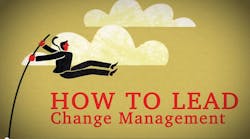10 Guiding Principles for Leading Change Management
According to a 2013 Strategy&/Katzenbach Center survey of global senior executives on culture and change management, the success rate of major change initiatives is only 54%. This is far too low. The costs are high when change efforts go wrong—not only financially but in confusion, lost opportunity, wasted resources, and diminished morale. When employees who have endured real upheaval, and put in significant extra hours for an initiative that was announced with great fanfare, see it fizzle out, cynicism sets in.
DeAnne Aguirre, senior partner with Strategy&, discusses techniques that can help companies transform quickly and effectively.The following is a list of 10 guiding principles for change that can help executives navigate the treacherous shoals of transformation in a systematic way—and help ensure that critical changes last for the long haul.
-
Lead with the culture.
In the Katzenbach Center survey, 84% of executives surveyed said their organization’s culture was critical to the success of change management, and 64% saw it as more critical than strategy or the company’s operating model. Yet change leaders often fail to address culture—in terms of either overcoming cultural resistance or making the most of cultural support.
Instead of trying to change the existing culture itself, skilled change managers draw emotional energy from it. They tap into the way people already think, behave, work, and feel to provide a boost to the change initiative. To use this emotional energy, leaders must look for the elements of the culture that are aligned to the change, bring them to the foreground, and attract the attention of the people who will be affected by the change.
-
Start at the top.
Although it’s important to engage employees at every level early on, all successful change management initiatives start at the top, with a committed and well-aligned group of executives strongly supported by the CEO. This alignment can’t be taken for granted. Rather, work must be done in advance to ensure that everyone agrees about the case for the change and the particulars for implementing it. This means top executives must engage in discussion, listen closely to one another, and weigh conflicting points of view in order to agree on a coherent vision for the goals of any major change initiative. Leadership, as the drivers of change, must act as a collaborative and committed team throughout the process.
-
Involve every layer.
Strategic planners often fail to take into account the extent to which midlevel and frontline people can make or break a change initiative. The path of rolling out change is immeasurably smoother if these people are tapped early for input on issues that will affect their jobs. Frontline people tend to be rich repositories of knowledge about where potential glitches may occur, what technical and logistical issues need to be addressed, and how customers may react to changes. In addition, their full-hearted engagement can smooth the way for complex change initiatives, whereas their resistance will make implementation an ongoing challenge.
-
Make the rational and emotional case together.
Leaders will often make the case for major change on the sole basis of strategic business objectives such as “we will enter new markets” or “we will grow 20% a year for the next three years.” Such objectives are fine as far as they go, but they rarely reach people emotionally in a way that ensures genuine commitment to the cause.
Human beings respond to calls to action that engage their hearts as well as their minds, making them feel as if they’re part of something consequential. By drawing directly on the company’s cultural history and traditions, leaders can activate a strong personal connection between the company and its employees.
-
Act your way into new thinking.
Many change initiatives seem to assume that people will begin to shift their behaviors once formal elements like directives and incentives have been put in place. Yet far more critical to the success of any change initiative is ensuring that people’s daily behaviors reflect the imperative of change. Start by defining a critical few behaviors that will be essential to the success of the initiative. Then conduct everyday business with those behaviors front and center. Senior leaders must visibly model these new behaviors themselves, right from the start, because employees will believe real change is occurring only when they see it happening at the top of the company.
-
Engage, engage, engage.
Leaders often make the mistake of imagining that if they convey a strong message of change at the start of an initiative, people will understand what to do. Nothing could be further from the truth. Powerful and sustained change requires constant communication, not only throughout the rollout but after the major elements of the plan are in place. The more kinds of communication employed, the more effective they are. Symbolic actions reinforce the impact of words.
-
Lead outside the lines.
Change has the best chance of cascading through an organization when everyone with authority and influence is involved. In addition to those who hold formal positions of power—the company’s recognized leaders—this group includes people whose power is more informal and is related to their expertise, to the breadth of their network, or to personal qualities that engender trust.
We call these informal leaders “special forces.” They might include a well-respected field supervisor, an innovative project manager, or a receptionist who’s been at the firm for 25 years. Companies that succeed at implementing major change identify these people early and find ways to involve them as participants and guides. Informal leaders must be identified before they can be engaged. The best way to do this in a large organization is to run a network analysis. By mapping out connections and seeing who people talk to, you can complement the formal org chart with one that enables you to lead outside the lines.
-
Leverage formal solutions.
Persuading people to change their behavior won’t suffice for transformation unless formal elements—such as structure, reward systems, ways of operating, training, and development—are redesigned to support them. Many companies fall short in this critical area.
After a strong start, a mentoring program for associates at a law firm faltered because no formal mechanisms were in place to support or reward this participation. Calculations for bonuses left development work out of the equation, and although senior partners paid lip service to the “wonderful work” the development committee was doing, they seemed to regard its members as internal volunteers. Once they recognized this problem, the firm’s leaders enacted substantial policy changes, starting with a mechanism the compensation committee could use to take into account the contributions made by those who trained others.
-
Leverage informal solutions.
Even when the formal elements needed for change are present, the established culture can undermine them if people revert to long-held but unconscious ways of behaving. This is why formal and informal solutions must work together. A top-tier technology company was trying to inculcate a more customer-centric mind-set after a decade focused on relentlessly cutting costs. A set of new procedures was put in place, but one of the most powerful solutions was purely cultural and informal—changing the informal motto that governed frontline decision making. By asking people at every level to be responsible for quality—and by celebrating and rewarding improvements—change leaders were able to create an ethic of ownership in the product.
-
Assess and adapt.
The Strategy&/Katzenbach Center survey revealed that many organizations involved in transformation efforts fail to measure their success before moving on. Leaders are so eager to claim victory that they don’t take the time to find out what’s working and what’s not, and to adjust their next steps accordingly. This failure to follow through results in inconsistency and deprives the organization of needed information about how to support the process of change throughout its life cycle.
These 10 guiding principles offer a powerful template for leaders committed to effecting sustained transformational change. The work required can be arduous and exacting. But the need for major change initiatives is only going to become more urgent. It behooves us all to get it right.
About the Authors:
- DeAnne Aguirre is a senior partner with Strategy& based in San Francisco. She is the co-leader of the firm’s global Katzenbach Center and an expert in culture, leadership, talent effectiveness, and organizational change management. She advises senior executives globally on organizational topics.
- Micah Alpern is a senior associate with Strategy& based in Chicago and a member of the Katzenbach Center’s operating team. He is an expert in culture transformation and organizational change management.




